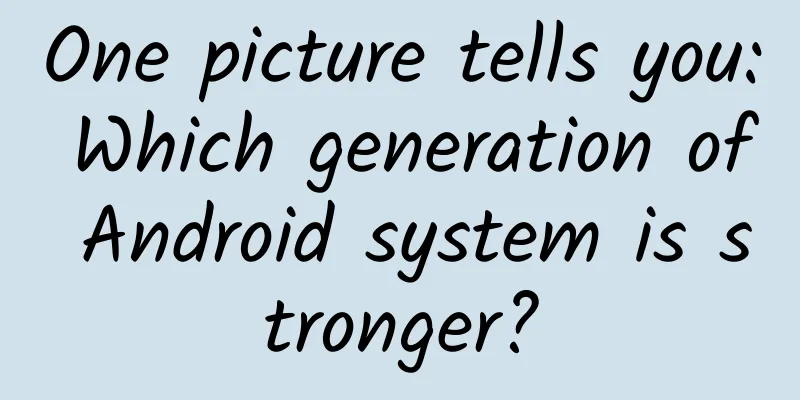One picture tells you: Which generation of Android system is stronger?

|
When Google released Android 1.5, it started naming it after desserts, and the size of the desserts that represented each version became larger and larger. Google released Android 5.0 Lollipop in mid-October 2014. As of early January 2015, it has been more than a month since the release of Lollipop. How is the performance now? According to Google's official data, as of early January 2015, there are almost no people using Lollipop. It has almost no market share among all Android devices, with a market share of less than 0.1%, as shown in the figure below, which is so small that it is almost invisible. One picture tells you: Which generation of Android system is stronger? Currently, most users still use the Android Jelly Bean system, which has a total market share of 46%, of which Android 4.1 accounts for 19.2%, 4.2 accounts for 20.3%, and 4.3 accounts for 6.5%. The second place is the previous version of "Lollipop", namely Android 4.4 KitKat (KitKat Chocolate), with a market share of 39.1%. It is worth mentioning that 4.4 successfully broke through the 1.1% share within one month after its official release. The market shares of the remaining Android versions are: Android 2.3 Gingerbread (7.8%), Android 4.0 Ice Cream Sandwich (6.7%), and Android 2.2/2.2.1 Froyo (0.4%). This also shows that Android is still facing the problem of version fragmentation, with multiple versions of the Android system being used by users at the same time. Although Google announced the developer preview version of Lollipop at the I/O Developer Conference on June 26 last year, companies such as Samsung, Motorola and LG have launched flagship models equipped with the Android 5.0 system, but the lagging system updates of other manufacturers have resulted in the "Lollipop" system being far from popular enough. For those who use Android, which system version are you using now? Attached are the names and release dates of several Android versions: Android 1.5 Cupcake 2009.4.30 Android 1.6 Donut (Donut) 2009.9.15 Android 2.0/2.0.1/2.1 Eclair (Muffin) 2009.10.26 Android 2.2/2.2.1 Froyo (frozen yogurt) 2010.5.20 Android 2.3 Gingerbread (Gingerbread) 2010.12.7 Android 3.0 Honeycomb 2011.2.2 Android 3.1 Honeycomb 2011.5.11 Android 3.2 Honeycomb 2011.7.13 Android 4.0 Ice Cream Sandwich (Ice Cream Sandwich) 2011.10.19 Android 4.1 Jelly Bean (Jelly Bean) 2012.6.28 Android 4.2 Jelly Bean (Jelly Bean) 2012.10.30 Android 4.3 Jelly Bean (Jelly Bean) 2013.7.25 Android 4.4 KitKat (KitKat Chocolate) 2013.11.01 Android 5.0 Lollipop (Lollipop) 2014.10.16 |
<<: Ten things you must know about the Windows 10 conference
>>: Android source code download: APP startup guide
Recommend
There are so many selling points for a product, how can we find the key points that impress users?
I believe many people have encountered this situa...
Metaverse NFT Industry Introductory Course (MPC)
Metaverse NFT Industry Introductory Course (MPC) ...
Amap APP full-link source code dependency analysis project
1. Background After years of development, the cod...
What should I do if GuangDianTong and Moments don’t work well?
There are countless channels for information flow...
WeX5 cross-terminal mobile development framework V3.2 official version released
WeX5 Enterprise Rapid Development Platform V3.2 O...
1 Gu Ailing = 100+ popular headlines?
The hot topic that marketers are paying attention...
【Short-term hot money】 Short-term hot money training course
【Short-term hot money】 Short-term hot money train...
How to solve the problem of inexplicable APP login on iOS 15
[[439486]] After iOS 15 was publicly launched, we...
Who to learn financial thinking development plan
Introduction to the resources of the GSX Financia...
The correct way to “value” social apps
“This is a social APP that will subvert WeChat!” ...
Gentle White is Not White · Douyin 0-cost project: single-day income of 500, no work release, no account maintenance [video course]
Gentle White is Not White · Douyin 0-cost project...
How to do bidding promotion? Here’s a universal method!
Many readers left messages in the background sayi...
Liu Heng's "Name Studies" 81 Numerology Determines the Changes in Life
Introduction to the content of the training course...
Five awesome WeChat interactive marketing success cases, have you tried them all?
On January 21, 2015, the fourth birthday of WeCha...
Operational case analysis: How to formulate an operational strategy?
In the first few years of operations , everyone w...






![[Girls' Emotions] Analyze 90% of emotional problems between the sexes and help you win the battle to defend your love](/upload/images/67cc26ca551bb.webp)


